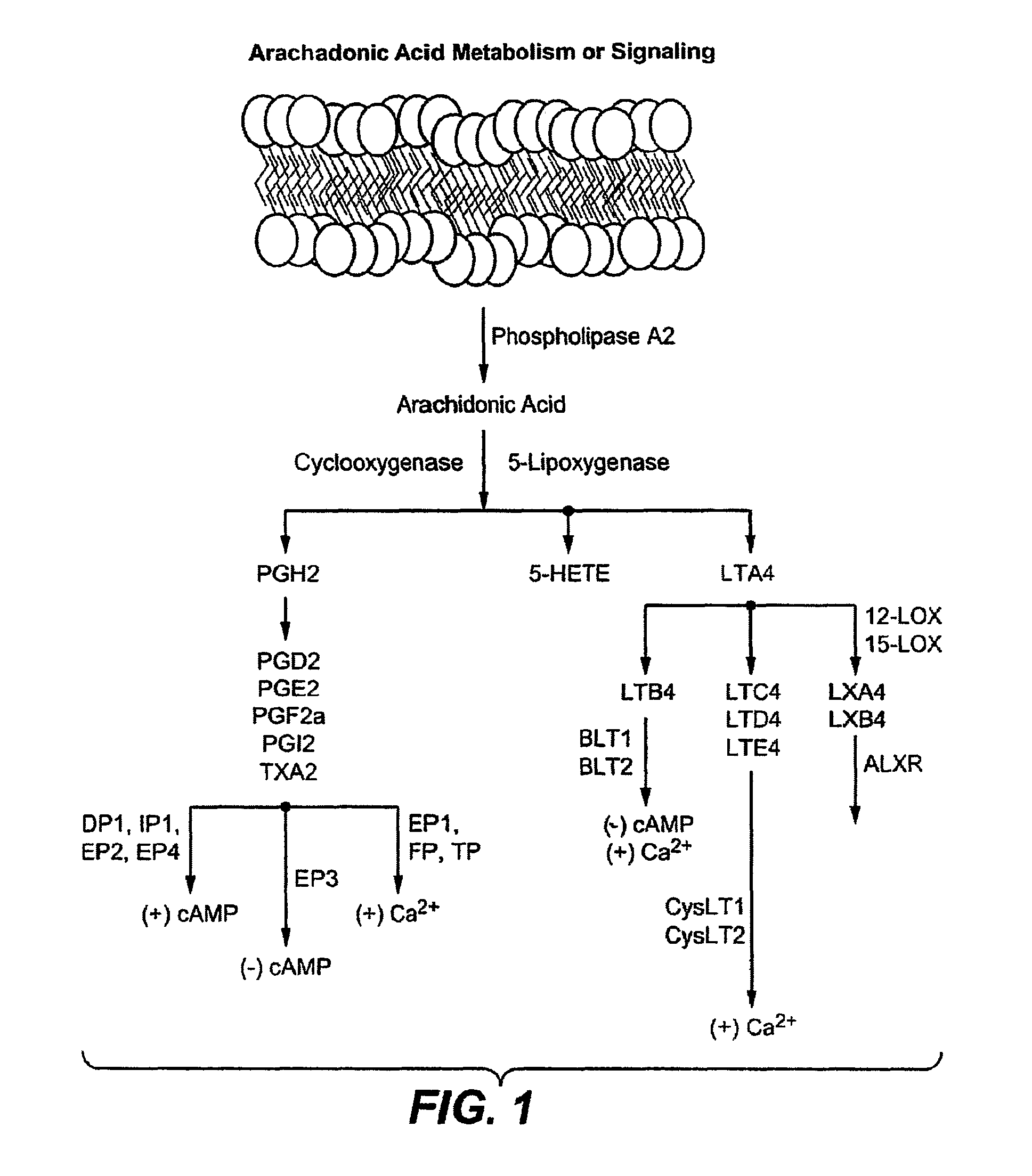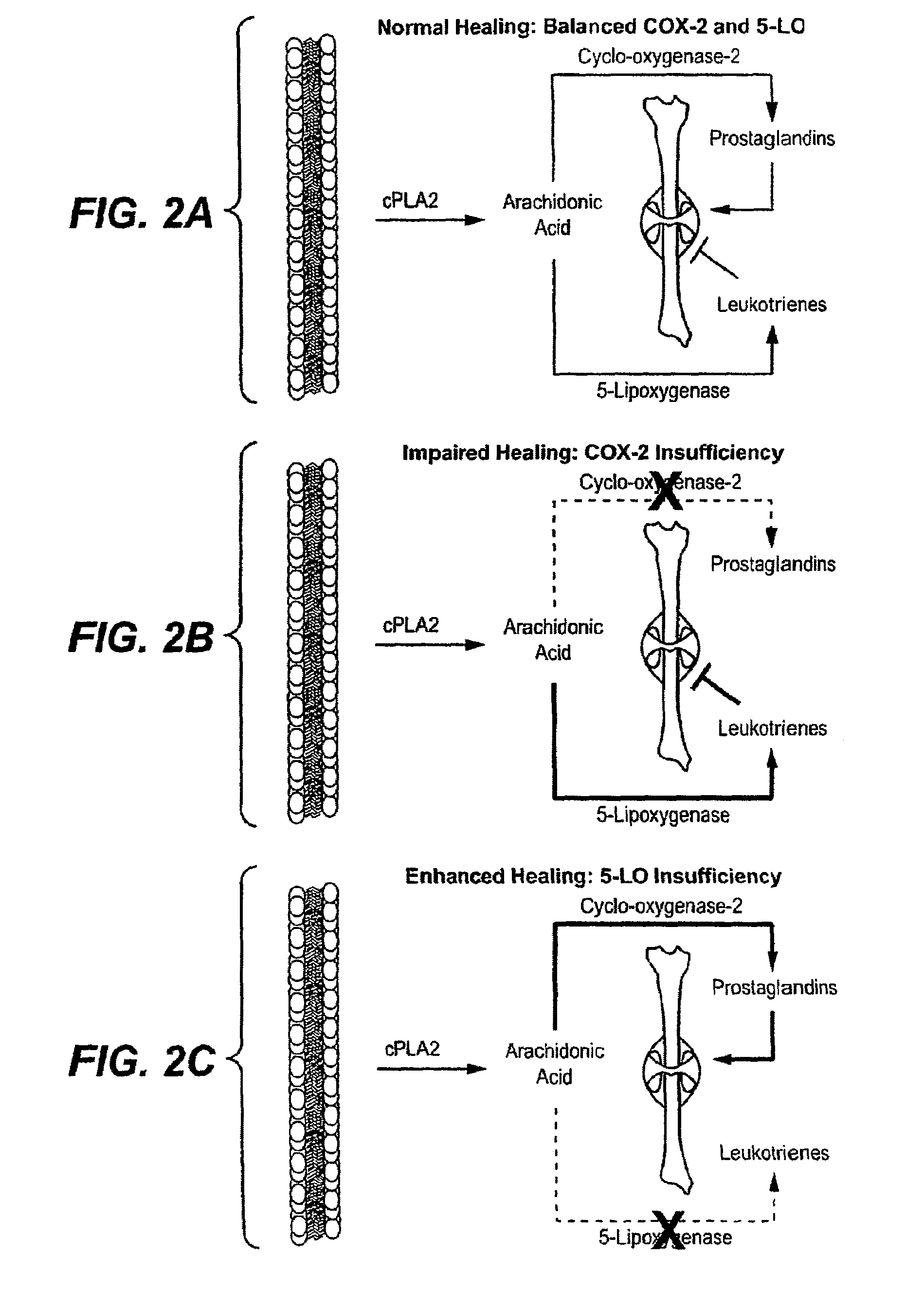Methods for bone treatment by modulating an arachidonic acid metabolic or signaling pathway
a technology of arachidonic acid and metabolic activity, applied in the direction of metabolism disorder, peptide/protein ingredient, extracellular fluid disorder, etc., can solve the problems of low activity of cyclooxygenase-1 (cox-1) and the likelihood of hip fractures in about one in every three women, and achieve the effect of reducing the activity of cyclooxygenase-1 and increasing the activity of cyclooxygenase-2 (cox-2)
- Summary
- Abstract
- Description
- Claims
- Application Information
AI Technical Summary
Benefits of technology
Problems solved by technology
Method used
Image
Examples
example 1
5-LO Knock Out Mice
[0086]Knock out mice lacking 5-lipoxygenase (Alox5− / − or 5-LO− / −) were purchased from Jackson Laboratory, Bar Harbor, Me. An impending femur fracture was stabilized with an intramedullary wire that was inserted retrograde into the femoral canal. A three-point bending device was used to male the fracture. Femur fracture healing was measured or assessed by histomorphometry, radiography, and torsional mechanic testing. The 5-LO− / − mice demonstrated statistically significant, quantitative acceleration and enhancement of fracture healing as compared to wild-type mice of identical genetic background and age (C57BL / 6). Closed mid-diaphyseal fractures were made in 10-12 week old female mice. Fracture healing was assessed by x-rays (FIG. 3) and quantitatively assessed by torsional mechanical testing 4 and 12 weeks after fracture (FIG. 4 and TABLE 2). After 4 or 12 weeks of healing, the fractured femurs from 5LO− / − and wild type (WT) mice were excised and mechanically teste...
example 2
COX-2 Knockout Mice
[0090]Fracture healing was assayed in mice with a targeted deletion of the COX-2 gene. Closed, mid-diaphyseal femur fractures were made in the right hindlimb of COX-2 knockout, COX-1 knockout, and wild type mice (not shown). Fracture healing was assessed by x-rays and histology (FIG. 6), and by mechanical testing (not shown). The data show that fracture healing was dramatically impaired in the COX-2 knockout mice, but not the COX-1 knockout or wild type mice. X-rays after 14 days of healing show a large mineralized fracture callus in the COX-1 knockout mouse (FIG. 6) with little or no evident mineralized callus in the COX-2 knockout mouse. Histological examination confirmed the x-ray findings in that the COX-2 knockout callus had a significant amount of cartilage but no new bone was evident. Torsional mechanical testing data shows that fracture callus structural and material properties are statistically significantly worse than COX-1 knockout or wild type mice. Wh...
example 3
Treatment of Rats with a 5-Lipoxygenase Inhibitor
[0091]Sprague-Dawley rats (3 months old) underwent a standard closed femur fracture procedure as described in the art (Simon et al. Journal of Bone and Mineral Research, 17(6): 963-976 (2002); Bonnarens and Einhom, Production of a standard closedfracture in laboratory animal bone. Journal of Orthopaedic Research, 2: 97-101 (1984)). The impending fracture was stabilized with an intramedullary stainless steel pin. Beginning 4 hours after fracture the rats were treated with 30 mg / kg of NDGA (nordihydrogaiaretic acid) in 1% methylcellulose (5-lipoxygenase inhibitor treatment group) or with carrier only (1% methylcellulose). The day after surgery and continuing until day 14 post-fracture, experimental rats were treated with 2 doses of NDGA (30 mg / kg), the first dose between 8-10 AM and then again with another NDGA dose 8-10 hours later. Control rats were treated similarly but with carrier only (1% methylcellulose). Three weeks after fractu...
PUM
| Property | Measurement | Unit |
|---|---|---|
| molecular weight | aaaaa | aaaaa |
| electromagnetic field | aaaaa | aaaaa |
| bone mineral density | aaaaa | aaaaa |
Abstract
Description
Claims
Application Information
 Login to View More
Login to View More - R&D
- Intellectual Property
- Life Sciences
- Materials
- Tech Scout
- Unparalleled Data Quality
- Higher Quality Content
- 60% Fewer Hallucinations
Browse by: Latest US Patents, China's latest patents, Technical Efficacy Thesaurus, Application Domain, Technology Topic, Popular Technical Reports.
© 2025 PatSnap. All rights reserved.Legal|Privacy policy|Modern Slavery Act Transparency Statement|Sitemap|About US| Contact US: help@patsnap.com



